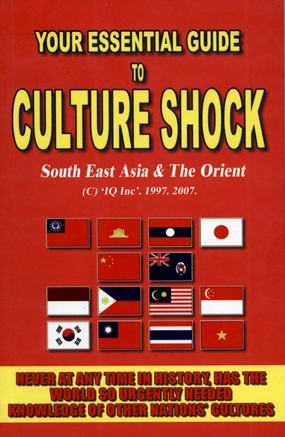This book was reviewed six years ago, and was a very popular title. However, all the pitfalls are still present, so the book remains current. You may have to ‘amazon’ it.
Your Essential Guide to Culture Shock, SE Asia and the Orient (ISBN 974-7313-80-2) was published by the IQ Inc people and was compiled and edited by Jake Anthony.

The foreword states the obvious, in some ways – there are aching chasms of difference between the Oriental East and the Occidental West; however, editor Jake Anthony then highlights those appealing factors in the East, such as the cultural diversity and polite natures, saying that it is difficult to imagine better holiday locations, but when the reader is someone contemplating business, or settling in the East, the aching chasms appear again. In an attempt to bridge those chasms, or at least forewarn, this book has been written.
The countries covered are Burma, Cambodia, China, Hong Kong, Indonesia, Japan, Laos, Malaysia, Philippines, Singapore, South Korea, Taiwan, Thailand and Vietnam.
Make no mistake, this is not another of the “guides to …” which will tell you the cheapest bus to get to XYZ, and where you and your backpack can doss down for less than $5 a day. This is much more of a serious attempt to unravel the knotted conundrum of working with the Asian mentalities.
Like the usual guides, there is an initial grounding given on the size of the area, some historical facts which have a bearing on today, and other pertinent items, before getting into the nitty-gritty of visas, immigration, work permits, currency and getting around.
Following those general details, the book gets into ‘culture shock’ with each location. The oriental ‘face’ concept is explained in depth, and how it can affect all business dealings, especially those with foreigners. From there, the book covers ‘Essential business dealings’ and ‘Understanding local customs’, knowledge of all of which can also spell success or failure. Even what you should do when receiving business cards is covered, and I must admit I have been errant in that regard. I now know what to do!
Each country finishes with a list of all the public holidays, then trade fairs and some useful addresses and some contact phone numbers. Again this is extremely worthwhile data – coming to Thailand for a business trip on the first week of May would be very frustrating, with public holidays on May 1, May 5 and May 7.
At B. 450, this should be compulsory reading for anyone contemplating business in SE Asia. Understanding when “yes” means “maybe” and when “maybe” means “no” will cut short many weeks of fruitful/fruitless (delete whichever is appropriate) endeavors. Whilst many of the concepts/mores/customs are common, as the heritages are often common, there still lies appreciable differences between the countries and their inhabitants.
I found the book fascinating, and there was much to absorb. It was also interesting that all of the different countries have a word to describe the ‘big nosed white faced, smelly foreign devil’. Yes, that’s us folks! Definitely deserves a place in all business bookshelves.




